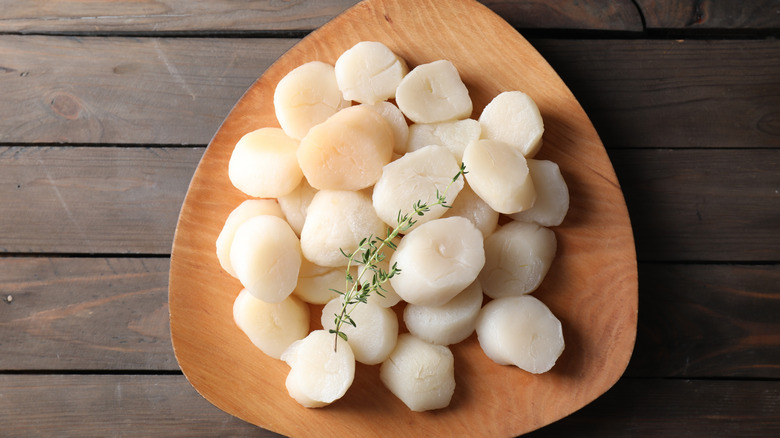Avoid Cooking This Kind Of Scallop If You Want A Perfect Sear
Scallops are a wonderfully tender eating experience, made infinitely better with a good sear. That sear gives the sweet and soft flesh a contrasting bit of crispy texture along with some caramelized flavor, but it does take a little nuance to achieve. In this case, we're talking about sea scallops, which are the larger meatier ones, as opposed to bay scallops, which are small and more for incorporating into things like soup or pasta. (Fake scallops are unfortunately a thing, but they have some telltale signs to them.)
But it's not all about cooking techniques. If you want to get the best type of sear from your scallop (trust me, it's worth it), you're going to want to look for a key difference in your purchasing options: wet versus dry. A wet scallop has been treated with a water and sodium tripolyphosphate solution, which preserves them after they've been harvested. The scallops retain more water weight when packed this way. Dry scallops are unadulterated and simply do not receive this type of treatment.
The result is that wet scallops are more, well, wet. If you try searing them, they release extra moisture, which is the enemy of searing, since you want a dry surface to get that coveted color to them. Some people also notice a slightly soapy flavor to wet scallops too, which is also not that fun, considering scallops are priced like a luxury ingredient. Dry scallops just don't have this problem, so they sear better and have a purer, more concentrated shellfish flavor — which is much more ideal.
How to know if you're buying wet or dry scallops
So how do you know which type of scallops you're purchasing at the store? Well, it's not necessarily straightforward. If you're getting them from a specialty fishmonger, it's easiest to ask, especially if you're requesting them from the display case. If you're getting them pre-packaged, you can look at its ingredients list; wet scallops should disclose the usage of sodium tripolyphosphate and water.
But if you're still not sure, and you're willing to experiment with one scallop, you can pop it in the microwave for 15 seconds on top of a paper towel. If the scallop is dry, you won't see much liquid on the paper towel, but a wet scallop will leak enough water to show a ring around its base. And don't worry, that scallop isn't scrap now — you can still cook with it.
If you ended up purchasing wet scallops, don't be disappointed. You can still get a sear out of them. You simply have to make sure you do your best to pat their flat surfaces as dry as possible, and cook it on high heat until a crust forms. It'll still taste good, especially with brown butter (which you can make beforehand) and a squeeze of lemon juice. You just might have to cook it for longer, and the sear might not be as immaculate as a dry one, which is why it's always worth seeking out that information prior to buying them.

